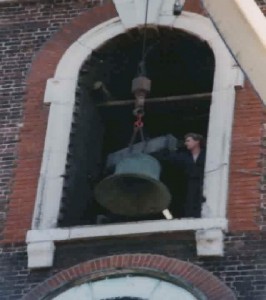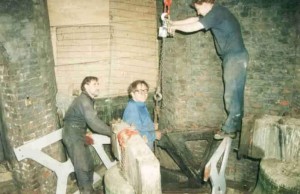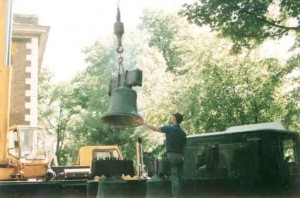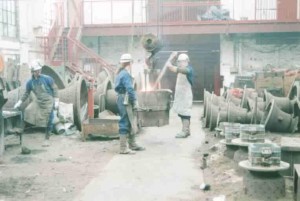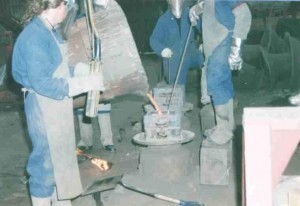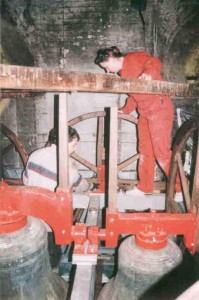|
By then end of 1995 we had raised sufficient money to place the order to carry out the restoration of the bells. The old eight were last rung on 1st June 1996 and the first task was to dismantle the bells frame and fittings. A team of volunteers carried this out over the following week-ends. The bell-hanger, Andrew Mills of Hayward Mill Associates arrived on Monday 15th July to supervise the final dismantling and prepare for the operation to remove the bells and frame from the tower. A crane was hired to lift everything from the louvres and load everything on to a lorry. This was carried out on Wednesday 17th July. Once the bells had been delivered to John Taylor’s Bellfoundry at Loughborough, Leicestershire, it was found that an iron loop, cast into the crown (top) of the old 5th bell (the new 7th) had rusted and cracked the bell. One option was to recast the bell, but as it was one of the original Thomas Lester bells from 1748, we were reluctant to do this. |
| Luckily, in recent years a process has been developed where the bell can be heated and welded to repair the crack. This work was carried out at the works of Soundweld, at Lode near Cambridge. This has proved to be successful and no-one would know that the bell has been welded. | |
| (l to r) Mike Todd, Michael Shelly and Andrew Mills (bellhanger) dismantling the frame and bells. | 17th July 1996 – the bells are craned on to a lorry to go away to Taylor’s Foundry at Loughborough. |
| On Thursday 26th September, the two additional treble bells were cast at Taylor’s Foundry. A party from the Parish travelled to Loughborough to witness the event, and also to look round the excellent bellfoundry museum adjacent. | |
| The bells and their new frame were delivered back to Rotherhithe on 20th January 1997 and over the next two weeks the frame was installed and the bells hung.Although we did manage to ‘try-out’ the new ring on the Friday evening, unfortunately at this time an un-related problem with the spire was discovered by the new church Architect.
The columns supporting the spire are doweled together with iron bars and some had rusted and caused the stone to split. Although we did look at the possibility of inserting temporary props, it was not considered to safe to ring the bells with them and we had to wait till cracked columns were repaired. The parish has worked hard to raise the money for this unforeseen expense and the work was undertaken in the summer of 1999. Now that the scaffold around the spire has come down, we are able to start to ring the bells. The first practices were held in August, and the dedication took place onSunday 5th September. Regular ringing commenced at the beginning of October. All that remains is for the clock auto-wind mechanism to be repaired and the project will be complete. |
What about the volume?
Care has been taken in designing the installation to retain a floor above the bells. This will have a set of hinged trapdoors to control the volume of sound.
For practice sessions we hope to make the bells very quiet indeed. Our experience elsewhere is that neighbours will hardly notice the bells being rung.
On Sundays, and when the bells are rung for weddings or other special services, these trapdoors will be opened to let the sound out.
Because the bells are now lower in the tower than previously, they will be less loud, but the sound will be more evenly mixed, and as it is travelling upwards, will carry long distances.
What did it cost ?
The cost of restoring the bells in 1997 was £45,000 although many people gave up their spare time to help keep the cost down. The cost could have been up to £75,000 if all the work had been carried out professionally. Donors include:
- The London Docklands Development Corporation,
- The Surrey Association of Church Bellringers,
- The London County Association of Church Bellringers
and many others.
The cost of restoring the spire was £80,000 the majority being given by the Heritage Lottery Fund, although we have still to find £20,000 to pay the final bills.
Article by Roger Booth

